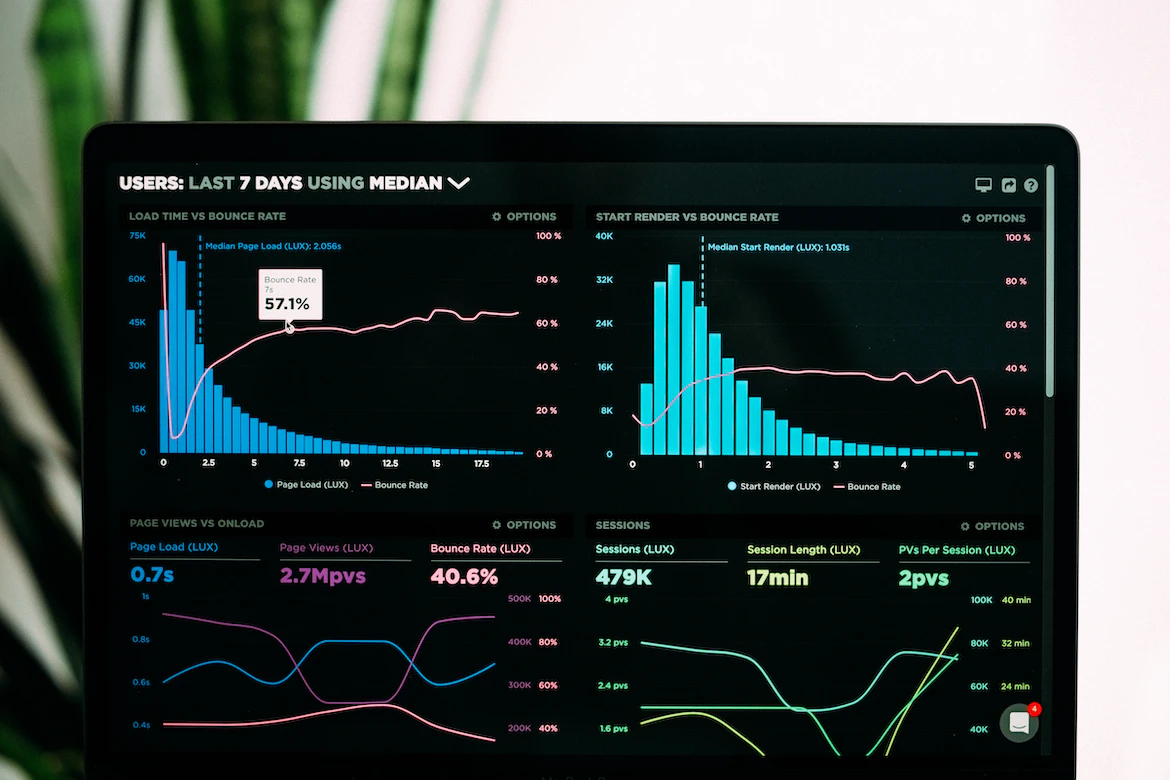Are you tired of inaccurate sales forecasts that leave your business struggling to keep up with demand? You’re not alone. A study by the Harvard Business Review revealed that incorrect sales forecasts are one of the primary challenges for sales managers. But don’t lose hope just yet – in 2023, the solution to this problem is closer than ever. Predictive analytics is revolutionising how businesses approach sales forecasting, offering increased accuracy, reduced errors, and improved decision-making.
This article will discuss predictive analytics, how it works for sales forecasting and some benefits and challenges related to its use in 2023.

Source: Unsplash
What is Predictive Analytics in Business?
Predictive analytics is the practice of using historical data to predict future outcomes. It uses advanced machine learning algorithms and statistical modelling techniques to identify large datasets’ patterns, trends, and correlations.
In business, managers can use predictive analytics for various tasks, including sales forecasting, customer segmentation, pricing optimisation, risk management, etc. Predictive analytics allows companies to gain insights into customer behaviour and market trends, which managers can use to optimise sales and marketing strategies, improve customer experience, and increase revenue.
Application of Predictive Analysis in Business
Predictive analytics has many applications in the business world across all industries. A few examples are:
- Retail and eCommerce: You can quickly analyse buyers’ behaviours in the retail and eCommerce or online business sectors and plan your inventory and marketing efforts accordingly.
- Healthcare: Innovative use of predictive analytics can revolutionise healthcare and improve outcomes for countless lives. Geisinger Health is a prime example of this; they used their model to analyse health records from over 10,000 past sepsis cases and found that it could accurately predict which patients would survive with a high degree of accuracy.
- Manufacturing: Predictive analytics can forecast demand and optimise production schedules.
- Insurance: Predictive analytics can also predict customer churn in the banking and finance industry or healthcare costs in the insurance sector.
- Finance: As predictive analytics can combine various data sources, it gives you an accurate estimate when predicting risks associated with projects and financial investments.
- Service: You can identify customer pain points and anticipate their needs by analysing large datasets with predictive tools.
Business leaders have quickly embraced predictive analytics due to the potential for substantial benefits. A market study from Future Market Insights found that the global predictive analytics market size in 2022 was $5.1 billion and is expected to skyrocket to $55.5 billion by 2023, with a CAGR of 15.8%.
Companies have tapped into this technology’s power to identify opportunities, reduce risks, and optimise processes – especially regarding sales forecasting.
Predictive Analytics For Sales Forecasting In 2023
In 2023, predictive analytics for sales forecasting will become increasingly common among businesses of all sizes. By leveraging large datasets, companies can use predictive analytics to forecast customer demand and plan their production accordingly.
How Does Predictive Analytics Differ from Traditional Sales Forecasting?
Unlike traditional methods that rely on manual input from sales reps or surveys, predictive analytics offers an automated and AI-driven approach to sales forecasting. This allows companies to quickly identify market trends, adjust their strategies in real-time, and create more accurate forecasts over the long term.
Predictive analytics has revolutionised the use of AI in marketing. It helps generate actionable insights in several areas, such as
- Analysing business performance based on various metrics and indicators, including qualitative and quantitative ones.
- Allowing the sales team to identify the best ways to reach the leads effectively.
- Setting realistic and achievable sales objectives and goals.
By leveraging predictive sales analytics, sales managers and teams gain a deeper understanding of their customers and prospects. This allows them to identify which products are performing the best, leading to quickly moving through the pipeline and any potential missed opportunities. By analysing critical elements of their current pipeline, this type of analytics helps salespeople stay ahead of the curve – giving them an edge to maximise revenue potential.

Source: Unsplash
Benefits of Predictive Analytics for Sales Forecasting
Using predictive analytics for sales forecasting has several benefits to businesses, including
Utilising AI And ML To Generate Unbiased Data
A forecast bias occurs when one or more variables are under-represented or over-represented in a forecast. This can lead to inaccurate results, with incorrect predictions for future sales.
By utilising AI and machine learning algorithms, predictive analytics allows businesses to avoid this bias. These algorithms can handle large datasets and consider all the relevant variables, such as customer behaviour and seasonality. By doing so, they generate unbiased data to create more accurate sales forecasts.
Real-time Modification of the Variables
When using traditional forecasting models, businesses can adjust only a few variables. For example, they can change the forecast based on the average sales of previous months or years. It is often expensive and time-consuming to recreate the forecast with different variables.
However, predictive analytics enables businesses to modify all relevant variables in real-time. This includes using data from customer behaviour and any external factors that might affect demand for their products or services. These adjustments ensure that forecasts remain accurate and up-to-date even when market conditions change rapidly – something traditional models cannot do.
Instant Availability at Low Cost
Typically, in a traditional sales forecast process, businesses require a large team of experts to analyse data and generate the forecast. You may need professionals with data science, marketing, and finance expertise. This can be expensive and time-consuming. Also, formatting and preprocessing of the collected data involve manual work, which can be tedious and prone to errors.
On the other hand, many predictive analytics tools are available in a subscription model, meaning you can access them anytime and anywhere. Moreover, they are relatively inexpensive compared to hiring a team of experts.
Also, the initial investment is typically low, and many tools offer free trials. This makes predictive analytics more accessible to businesses of all sizes and budgets. Many modern-day CRM software now natively include predictive analytics for lead management and sales forecasting.
Generating High-prospect Leads
The sales forecast is only as good as the leads it generates. So predictive analytics often takes it one step further and helps businesses to identify high-prospect leads. By analysing customer data, predictive analytics algorithms can determine the best prospects for a given product or service. This allows companies to narrow their target audience and focus marketing efforts on more promising leads.
Typically, sales teams spend a large chunk of their time trying to identify and contact potential customers. Predictive analytics can help them save this time by automatically identifying the most promising leads.
Creating Personalised Marketing Strategies
Once you identify your prospects or leads, the next step is to develop the most optimal marketing strategy, where predictive can significantly help.
Predictive analytics algorithms analyse customer data and identify the most effective marketing channels, messages and campaigns for each customer segment. This allows sales teams to create personalised marketing strategies tailored to their customer’s needs and preferences.
You will even learn the ideal time to reach a customer. For instance, predictive analytics can help you identify the best time to send promotional emails or launch special offers based on past data on consumer behaviour or marketing campaigns.
Also, you can develop different offers and messages for a diverse group of your leads. For instance, your promotional offer should differ for first-time visitors from returning customers.

Source: Unsplash
Identifying Upselling and Cross-selling Prospects
One of the most critical aspects of successful sales forecasting is understanding the customer’s needs. By analysing customer data, predictive analytics can help businesses identify upselling and cross-selling opportunities. This includes past purchases, browsing patterns, reviews, and other consumer behaviours.
For example, if a customer has bought a product once, the algorithm can identify whether they will repurchase it depending on personal traits and past experiences. This allows businesses to target customers with the right product and increase their chances of success.
Assessing with Product Launch
It’s tricky to gauge the potential success of a new product launch. Predictive analytics allows businesses to evaluate the feasibility of launching a new product by analysing past trends and customer data.
Using predictive analytics, businesses can get an insight into what customers think about the product beforehand and identify potential pitfalls with its launch. This helps them make informed decisions about whether or not to go ahead with the launch, ensuring that they only invest in products that are likely to be successful.
You can include many risk factors associated with product launches, such as customer demand and competition. This helps businesses determine whether they should invest in the launch or not.
How Predictive Data Analytics Works for Sales Forecasting?
Now that we know the benefits of predictive analytics for sales forecasting let’s look at how it works. Predictive data analytics is an AI-driven technology that uses historical data to predict future outcomes. It combines traditional statistical methods with machine learning algorithms to analyse past behaviour and anticipate future trends.
The process occurs in three stages: data collection, analysis, and prediction. Let’s now look at each of these stages in more detail.
Stage 1: Data Collection and Integration
The first stage of predictive analytics for sales forecasting involves collecting and integrating the necessary data. This includes internal data, such as customer demographics, purchase history, and market trends, and external data sources, like news articles, economic indicators, and social media sentiment.
Businesses may use many sources to gather this data, such as surveys, customer feedback forms, and third-party sources. Once collected, the data is integrated into a unified system that you can use for further analysis.
There are several individual activities within this phase, as follows:
- Data capture: Data extraction from multiple sources
- Data cleansing: Removal of errors, outliers, and duplicates
- Data preparation: Formatting the data for further processing
- Integration: Combination of different datasets into a single system
- Warehouse creation: Establishing a secure data repository
Stage 2: Modelling and Analysis
The second phase involves modelling and analysing the data. This is where predictive analytics tools, such as machine learning algorithms, natural language processing (NLP), and deep learning models, come into play.
These tools analyse the data to identify patterns and relationships for making predictions. For example, a deep learning model may use past customer purchase history to predict future buying behaviour.
Data scientists build multiple modelling scenarios to assess the accuracy of each model and then select the best one for forecasting. Once the model is selected, it is tested against new data sets to ensure accuracy.
Stage 3: Prediction Output and Reporting
The final stage of predictive analytics for sales forecasting is the prediction output and reporting. In this stage, the data analysis from the previous stages is used to generate a forecast for future sales. The results of this process are then presented in an easy-to-understand format that decision makers can use to make informed decisions about their sales strategy.
Analytics tools often come with custom dashboards that provide detailed insights into the performance of the sales forecast. It also lets you visualise key metrics such as average daily sales, projected revenue, and other related data points.

Source: Unsplash
Challenges of Implementing Predictive Analytics for Sales Forecasting
While predictive analytics offers many benefits for sales forecasting, there are still some challenges associated with its implementation:
- Data Availability: Predictive analytics relies on large amounts of data to provide accurate forecasts. If the necessary data is unavailable, you will find it challenging to generate an appropriate forecasting report.
- Algorithms: For predictive analytics to be effective, the algorithms used must be tailored to a specific sales forecasting problem. This requires skilled personnel and can involve much trial and error before finding an optimal solution.
- Accuracy: Even with sufficient data and well-tailored algorithms, there will still always be some degree of uncertainty in any predictive model’s results. Therefore you should always consider any potential inaccuracies in the forecast.
- Adoption: Adopting predictive analytics into existing business systems is often challenging. It requires adequate training and support to ensure that staff are comfortable using the new system and integrating it with existing processes.
Although modern-day predictive analytics software solutions will handle most tasks in the backend, your team will still require some familiarity with the models used and data interpretation. So, be prepared to invest in the training and development of your sales team members.
Wrap-Up: What’s Next for Predictive Analytics for Sales Forecasting?
Predictive analytics is increasingly essential for businesses to optimise their sales forecasting accuracy. With its multitudes of benefits, such as improved accuracy and informed decision-making, predictive analytics will only continue to grow in prominence. As its technology advances further over the coming years, more businesses will be able to capitalise on it, enabling unprecedented sales forecasting precision.
At Virtuzone, we provide comprehensive support to UAE-based companies looking to incorporate predictive analytics into their existing systems. Our team boasts extensive experience and expertise in data collection, analysis, algorithm development and integration – so don’t hesitate to get in touch if you require assistance growing your business in the UAE.









